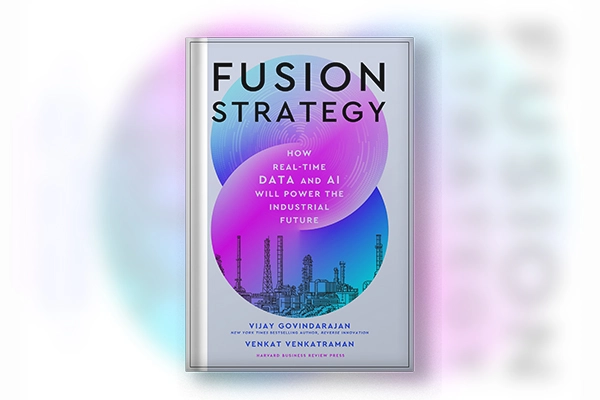Fusion Strategy

Fusion Strategy: How Real-Time Data and AI Will Power the Industrial Future” argues that industrial companies must embrace a “Fusion Strategy” to survive and thrive in an increasingly digitized global economy. This strategy involves the seamless integration of physical industrial products with digital technologies, particularly real-time data, Artificial Intelligence (AI), and Machine Learning (ML). The core concept revolves around “datagraphs,” dynamic representations of relationships between a company and its customers through “product-in-use data,” which, when analyzed by powerful algorithms, provide unprecedented competitive advantage. The book outlines a dynamic framework for four “fusion battlegrounds” – Fusion Products, Fusion Services, Fusion Systems, and Fusion Solutions – guiding industrial leaders on how to create and capture value, challenge existing competitive landscapes, and transform their businesses from analog to digital insight companies.
Main Themes and Most Important Ideas/Facts
A. The Impending Digitalization of the Industrial World
- Vast Untapped Market: The industrial sector, comprising traditional manufacturing, mining, transportation, logistics, construction, and healthcare, accounts for nearly 75% of the world’s $100 trillion GDP. This vast market remains largely untouched by digital technologies, but that is rapidly changing.
- “Almost 75 percent of it [world’s GDP] was created by traditional manufacturing, mining, transportation, logistics, construction, and health care industries. Those sectors haven’t been significantly changed by digital technologies yet. But they will be affected. Soon.”
- Historical Precedent from Asset-Light Sectors: Digital technologies have already “transformed” asset-light sectors like advertising, photography, music, and media. Companies that “misread the signals” lost their market leadership to “born-digital companies” like Netflix and Spotify, who “harness[ed] the power of user data and AI to develop new sources of competitive advantage.”
- New Inflection Point: Advances in hardware, software, applications, cloud, data, algorithms, Generative AI (Gen AI), and mixed reality are converging to reshape the global economy. These technologies are both a “threat to profitability” and the “biggest driver of how value creation and value capture evolve.”
- The Fusion Frontier: This future state involves industrial products infused with sensors, software, and real-time telematics, enabling “seamless convergence of physical and digital domains.” This allows for enhanced productivity, personalized problem-solving with algorithms, and a shift from simply designing “brilliant machines” to ensuring those machines “satisfy the specific needs of individual customers.”
B. Datagraphs: The Foundational Building Block of Fusion Strategy
- The Crux of Fusion: Real-time “product-in-use data” is the foundation. By systematically accumulating this data, companies develop “datagraphs,” which “capture the relationships, links, and interrelationships between a company and its customers through product-in-use data and are the fundamental building blocks of the fusion strategies.”
- Inspired by Social Networks: The concept draws from social networks and graph theory, powered by AI and ML. Datagraphs are “dynamic representations” whose algorithmic underpinnings “help to absorb more data, analyze more kinds of data, and advise on specific actions.”
- Data Network Effects: Datagraphs are driven by “data network effects, which are triggered when a company’s product gets smarter as it gathers more data from users of the product.” This creates a “virtuous cycle” where product enhancements lead to continued use, deepening the “data bond between products and customers.”
- Redefining Scale and Scope:Scale: In the industrial era, scale was linear (increased sales/market share). Datagraph-driven scale “stems from orchestrating an ecosystem whose members play complementary roles.” It’s about deep details of customer interaction, not just absolute numbers.
- Scope: Traditional industrial scope involved leveraging capabilities into “adjacent sectors.” Datagraphs, however, allow for “AI-driven problem-solving capabilities” to expand business scope into “many unrelated sectors.”
- Real-time Data vs. Static Data: Datagraphs rely on “data in motion” (real-time streams) unlike traditional “systems of record” (static data) or “systems of engagement” (periodic connections).
- Algorithms Animate Fusion: Datagraphs are valuable only when “algorithms must analyze them to develop actionable recommendations.” This involves four types of analysis:
- Descriptive: “What happened?” (historical)
- Diagnostic: “Why did it happen?” (root cause)
- Predictive: “What could happen?” (forecasting)
- Prescriptive: “What should happen?” (recommended actions)
- “Real-time data that feeds datagraphs and algorithms will help industrial companies win in the fusion future. There’s no fusion strategy without datagraphs; there’s no business value in datagraphs without authoritative algorithms. Fusion strategy is built on both datagraphs and AI.”
C. Generative AI as a Force Multiplier for Industrial Datagraphs
- Transforming Business Logic: Gen AI, with its ability to generate new content from foundation models, is poised to “transform business logic, create new sources of competitive advantage, and render traditional competencies obsolete.” Its impact is expected to be significant in “asset-heavy and information-rich” sectors.
- Richer Insights: Gen AI models “generate datagraphs on steroids to offer much richer insights.” This is already evident in “search wars” (Google’s Bard vs. Microsoft’s Bing) and “shopping wars” (Google’s Shopping Graph, Amazon’s review summaries, Meta’s ad tools).
- Industry-Specific Models: Specialized, industry-specific Gen AI models (e.g., BloombergGPT for finance, Khanmigo for education) will accelerate this transformation in industrial sectors, enabling complex designs, trend extraction from multimodal data, proactive responses to changing conditions, and handling of ambiguous data.
- Multimodal Data: Gen AI’s ability to process and generate from “multimodal data” (numbers, text, 3D images, voice) is crucial for industrial applications, allowing for “deeper insights.”
D. The Five Strands of Fusion
Fusion, in the context of digitalizing industrial sectors, consists of:
- Interlocking Physical and Digital Domains: Seamlessly blending historically separated functions (e.g., cars as computers on wheels, smart tractors).
- Intertwining Humans and Machines: Collaborative intelligence for new expertise and insights (e.g., Tesla’s AI team refining systems based on human driving data).
- Infusion of Digital Thinking into Analog Disciplines: Digital’s impact on sciences, arts, and engineering (e.g., sustainable farming via sensors and software, personalized medicine).
- Interlinking Physical and Virtual Worlds: Cloud, digital twins, mixed reality, and metaverses for real-time insights and efficiency gains.
- Interconnections Among Companies: Corporations becoming a “portfolio of capabilities through cross-industry ecosystems,” leveraging data interconnections for better product performance, streamlined processes, and superior customer service.
E. The Automotive Industry as a Leading Example
- Tesla’s Fusion Model: Tesla epitomizes a fusion company, building “fusion products” that are “data and AI companies that makes physical machines.” Key aspects include:
- Real-time Data Collection: Cameras and sensors collect data in motion.
- Fleet Learning: “Every driver is training the (neural) network all the time” to improve autonomous driving.
- Over-the-Air Updates: Regular software updates “transform” the car experience.
- Tripartite Twins: Tesla uses product, process, and performance twins to optimize everything from design to manufacturing to real-world performance and maintenance.
- Vertical Integration: Tesla designs its own chips (D-1), supercomputers (Dojo), and charging networks.
- Traditional Automakers Fighting Back: Companies like GM (Cruise), Alphabet (Waymo), Mercedes-Benz, and Volkswagen are also investing heavily in EVs, software-defined vehicles, and autonomous driving, acknowledging the need to become “digital engineering companies.”
- Shift in Competitive Advantage: The “laws of competitive advantage are changing, rewarding those who have the most-robust real-time insights rather than the most-valuable physical assets.”
F. Four Fusion Battlegrounds for Value Creation and Capture
Industrial companies must choose and dynamically pursue strategies across four battlegrounds based on the reach (extent of customer operations optimization) and richness (multidimensionality and scope) of their industrial datagraphs.
- The Battle of Brilliant Machines (Fusion Products):
- Focus: Digitalizing industrial products to observe performance in real time, generate data network effects, and continually enhance machine efficiency. “Fusion products will contain purpose-built chips for AI and and machine learning, which companies can use to monitor products’ performance in the field.”
- Value: Improved uptime, reduced downtime, and product refinements through predictive maintenance.
- Example: John Deere’s See & Spray and ExactShot, Tesla’s self-improving vehicles.
- Monetization: Premium pricing, performance contracts (guarantees based on actual data), or entering adjacent spaces (e.g., Tesla’s insurance).
- Key Idea: Moving beyond “digital bells and whistles” to truly smart products that capture and leverage real-time, product-in-use data.
- The Race for Remarkable Results (Fusion Services):
- Focus: Extending the reach of datagraphs into “customers’ operations to improve business outcomes.”
- Value: Boosting customer productivity and profitability beyond just machine uptime (e.g., increasing crop yields, optimizing fuel efficiency). “The holy grail of industrial services is customization at scale and speed.”
- Example: John Deere’s agritech strategy, Rolls-Royce’s R2 Data Labs for aircraft engine fuel efficiency.
- Monetization: Savings-based contracts, unbundled or bundled pricing, or data collection rights.
- Key Idea: “Fusion services interlink the company’s products with key business processes at customer operations.” This requires earning customer trust to access granular data.
- The Showdown of Smart Systems (Fusion Systems):
- Focus: Optimizing a “higher-order system of interconnected products” by linking machines from multiple vendors (including competitors) with application programming interfaces (APIs).
- Value: System-level efficiency and reliability, predicting subsystem failures, and unlocking value trapped in silos. “A system is not the sum of its parts, but the product of their interactions.”
- Example: Honeywell’s integrated building management systems (Burj Khalifa), Rolls-Royce’s Yocova platform for aviation.
- Monetization: Systems integration fees, annual connection charges, software-as-a-service.
- Key Idea: The locus of competition shifts from individual products to interdependent fusion systems, with an emphasis on “system-level datagraphs.” This requires “orchestrators” to coordinate ecosystems.
- The Clash of Custom Solutions (Fusion Solutions):
- Focus: Solving “each business customer’s unique problems in their entirety,” starting from the customer’s problem, not the manufacturer’s machines.
- Value: Comprehensive, customized problem-solving that integrates products, services, and systems, often across industries.
- Example: Tesla’s broad mobility solution (cars, ride-sharing, energy optimization), John Deere’s potential to become a precision agriculture solutions provider (beyond machines).
- Monetization: Outcomes-based contracts, profit-sharing, subscription models, “as-a-solution” businesses.
- Key Idea: Industrial companies become extensions of customer operations, acting as “trusted solutions architects” and knitting together the “best possible solutions” from an ecosystem of partners, potentially including rivals. Gen AI can help “frame different definitions of problems and generate multiple ideas to solve the problems.”
G. Principles and Practices for Conquering the Fusion Frontier
- Principle One: Unlock New Business Value Across Multiple StagesLet Hundreds of Experiments Bloom: Disciplined strategic experimentation across short, intermediate, and long-term horizons to discover precise means of unlocking value.
- Be the Best at Backcasting: Envisioning desired future conditions and working backward to define actions, especially in the face of discontinuous shifts, to identify “value stream breakpoints” and profit pool shifts.
- Principle Two: Design for Collaborative IntelligenceRetrain Today’s Workforce: Educate and train the workforce on how AI and advanced algorithms complement human skills, especially regarding tripartite twins and datagraph structures.
- Recruit Tomorrow’s Talent Base: Attract software engineers and AI experts who thrive in human-machine collaboration and cross-disciplinary work.
- Principle Three: Live (and Grow) in EcosystemsMake Ecosystems Deliver Today: Structure and manage partnerships (channel, technology, even competitors) to ensure data flows, coordination, and value creation from product performance through lifecycle.
- Adapt Your Ecosystems for Tomorrow: Proactively develop new relationships and rebalance existing ones as competitive landscapes and technologies evolve, making make-buy-partner decisions. “The point is not just which company is interconnected to which, but the patterns of dataflows from one company to others so that the system can be optimized.”
- Principle Four: Nurture Fusion LeadersCultivate Fusion Thinking Within the C-Suite: Achieve a “unified view of how, when, and where digital drives strategy” and shifts competitive battles to ensure aligned resource allocation.
- Inculcate Fusion Thinking Throughout the Organization: Upskill employees at all levels in digital technologies and foster a culture of curiosity and experimentation.
- Principle Five: Follow Your Strategy ScorecardUse Metrics That Match the Battles: Develop precise, specific metrics that reflect the company’s aspirations and track short- and long-term success in each battleground, focusing on customer productivity and profitability, not just machine sales.
- Shift When the Metrics Do: Dynamically adjust the scorecard and strategy as market conditions, rival actions, and technology developments indicate opportunities for new fusion strategies.
H. The Urgency of Action
- “The future depends on what you do today.” – Mahatma Gandhi
- “Most decisions should probably be made with somewhere around 70 percent of the information you wish you had. If you wait for 90 percent, in most cases, you’re probably being slow.” – Jeff Bezos
- “The fusion future is not a linear extrapolation of the industrial past. Today’s core competencies will not be enough to win tomorrow.”
Key Takeaways and Implications
- Existential Imperative: Digitalization is not an option but an existential imperative for industrial companies. Ignoring this shift will lead to being “left behind” by both digital natives and transformed incumbents.
- Data as the New Asset: Competitive advantage is shifting from physical assets to “robust real-time insights” derived from “information assets” – specifically, datagraphs and the algorithms that animate them.
- Beyond Incremental Change: Fusion Strategy demands “fundamental reinventions,” not “incremental adjustments.” This includes rethinking product architecture, organizational structures, talent acquisition, and ecosystem relationships.
- Collaborative and Ecosystem-Centric: Success hinges on fostering “collaborative intelligence” (human-machine cooperation) and participating in “network-centric” ecosystems that cut across industry boundaries.
- Dynamic Strategic Evolution: Companies must dynamically move through the four battlegrounds, starting with fusion products and progressively expanding into services, systems, and solutions as they build out their datagraphs and AI proficiency.
- Leadership Challenge: Top-down commitment, C-suite alignment, workforce retraining, and new talent acquisition are crucial for successful transformation. Leaders must balance “defending current profits while going after new pockets of value.”
- Measuring What Matters: Strategy scorecards must evolve beyond traditional metrics to reflect customer outcomes, data network effects, and the dynamic nature of fusion strategies.
Vijay Govindarajan (VG) is a globally recognized expert in strategy and innovation. He is a distinguished professor at the Tuck School of Business at Dartmouth College and is a faculty partner at Mach49, a Silicon Valley incubator. His work has earned him significant recognition, including being named the number three management thinker in the world by Thinkers50 in 2011 and his induction into the Thinkers50 Hall of Fame in 2019. He is the author of bestselling books such as Reverse Innovation and The Three-Box Solution, and his articles in the Harvard Business Review have won the McKinsey Award and are among the magazine’s bestsellers.
Venkat Venkatraman is a leading authority on digital technologies and business strategy. He is a professor at Boston University’s Questrom School of Business and has previously taught at the MIT Sloan School of Management and London Business School. He is a highly-cited researcher, recognized among the top 2% of scientists by Stanford University based on his citation record. Venkat is the author of the book The Digital Matrix: New Rules for Business Transformation through Technology, which is highly regarded for its insights into succeeding in the digital age.
Their combined expertise in innovation, strategy, and digital transformation is the foundation for their collaboration on Fusion Strategy.
Book details
- Title: Fusion Strategy
- Explanatory Title: How Real-Time Data and AI Will Power the Industrial Future
- Authors: Vijay Govindarajan, Venkat Venkatraman
- Publisher: Harvard Business Review Press
- Publication Date: March 12, 2024
- Print Length: 224 pages
- ISBN-10: 164782625X
- ISBN-13: 978-1647826253
- Category: Strategic Business Planning / Systems & Planning / Artificial Intelligence & Semantics

